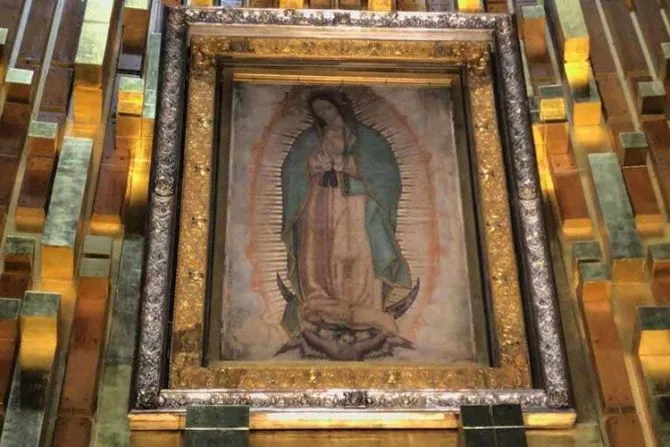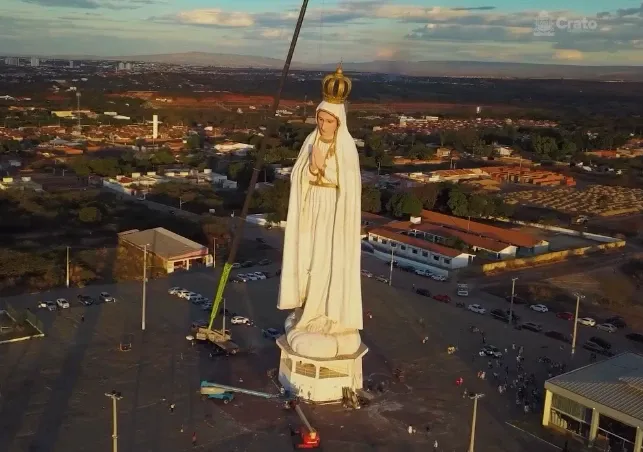Is Our Lady of Guadalupe a Catholic adaptation of an Aztec goddess?
Some scholars have promoted the idea that the Virgin of Guadalupe is a Catholic adaptation of the Aztec goddess Coatlicue Tonantzin, who is a combination of a woman and serpents, and a symbol of fertility.
However, Chávez said that Our Lady of Guadalupe is not an adaptation of a goddess and has nothing to do with idolatry.
“She’s not called Coatlicue, which would be idolatry; she’s called Tonantzin, which isn’t any kind of idolatry but means ‘our venerable mother’ and, as the Indigenous affectionately say, ‘our dearest mother.’ It’s a title, it’s not idolatry.”
“The missionaries of the 16th century would never have made up a costume for a pagan goddess. That’s completely false,” he underscored.
(Story continues below)
Is there music hidden in the image of the Virgin of Guadalupe?
Based on mathematical analysis, Mexican accountant Fernando Ojeda discovered music embedded in the image of Our Lady of Guadalupe, Chávez explained.
Viewing the flowers and stars in the image of the Virgin as if they were musical notes, Ojeda outlined and found a melody.
Chávez said that analysts repeated the experiment with copies of paintings from the 16th and 17th centuries, “where stars and flowers are placed at the painter’s discretion,” but the only thing they produced was “noise, not harmony.”
“Only with the original does a perfect harmony emerge, with a symphonic arrangement. It is true — music comes forth from the image of the Virgin of Guadalupe,” he affirmed.
Was there a light miraculously projected on the womb of the Virgin of Guadalupe?
For Chávez, “it’s hard to know if it was a miracle at that time because we don’t know if it was a ray of light that happened to hit upon one of the nearby metal objects, projecting a light on her womb.”
“What we do know is that she is the defender of life,” he said, pointing to “the simple fact that she has a dark ribbon over the womb, which means she’s pregnant and that therefore Jesus Christ Our Lord is in her immaculate womb.”
Can words be seen on the image of the Virgin of Guadalupe?
Responding to those who say they can see the word “peace” on the image, Chávez said “I don’t see that anywhere.”
“She communicates with glyphs as the Indigenous did. And when it was by words she spoke in Náhuatl through Juan Diego who later translated,” he said.
Did Bishop Juan de Zumárraga mistreat Juan Diego?
“The key, everything turns on the bishop,” Chávez said, since “although the Virgin of Guadalupe chose a layman, spoke to a layman, expressed her message to a layman,” the shrine she asked for “was not going to be done without the authority of the bishop.”
Chávez said it was instead the servants who treated St. Juan Diego badly when he went to see Bishop Juan de Zumárraga. “It was the servants who left him outside,” he said.
The Franciscan bishop “never treated him badly, on the contrary; he treated him with affection” as well as with “a lot of respect and much dignity,” Chávez said.
This story was originally published by ACI Prensa, CNA's Spanish-language news partner, and published on CNA on Dec. 12, 2019. It was updated Dec. 11, 2023.
Graduated in Communication Sciences from the Universidad Privada del Norte in Trujillo, Peru. I have been part of the ACI Prensa team for more than 10 years. I have covered Pope Francis' trips to Ecuador, Paraguay, Mexico, Colombia, Chile, and Peru. I covered the beatification ceremony of today's Saint Oscar Arnulfo Romero in San Salvador, El Salvador, in 2015. Special envoy for investigation in Honduras in 2016. Head of the ACI Prensa Office in Mexico since 2018.








